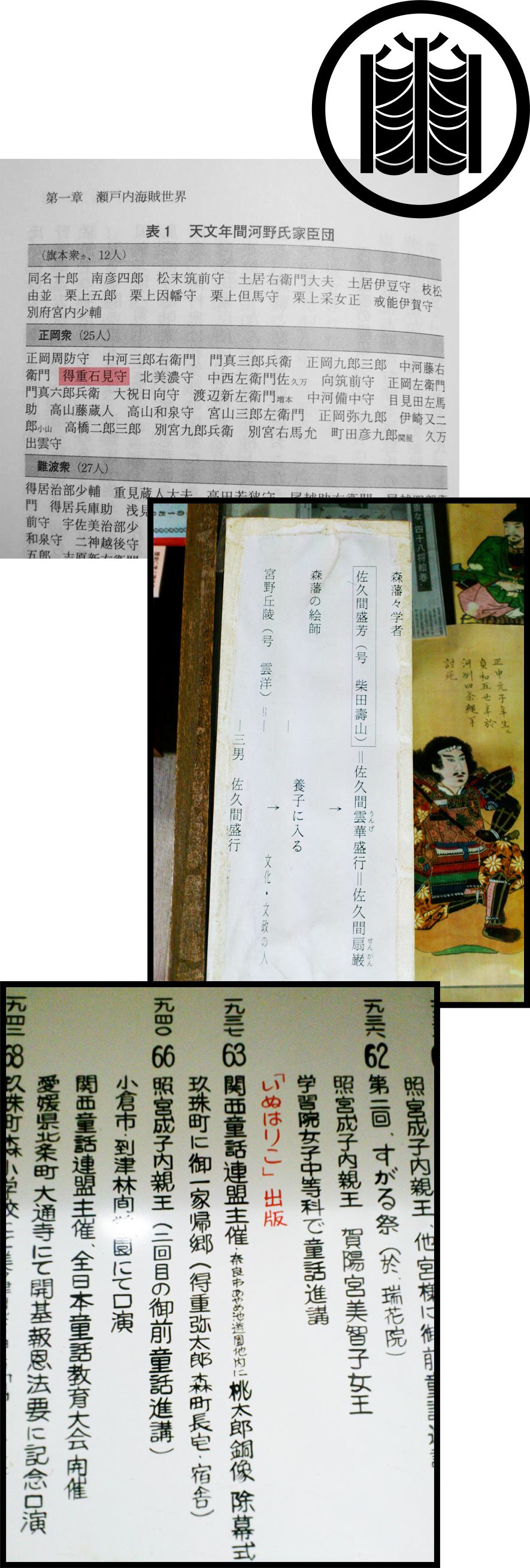


The painter Seiji Tokushige spent his childhood in Kusu Town, Kusu County, Oita Prefecture.
I would like to note a few historical aspects.
The Tokushige family was a vassal of a feudal lord named Kurushima, who had this Kuju town as his domain (Mori domain) (*1). The roots of the Tokushige family are the descendants of the Kurushima navy, which was active in the Seto Inland Sea as part of the Murakami navy. After the Battle of Sekigahara, he established the Mori Clan based in a mountain castle in Kusu Town (the former Mori Clan). For this reason, the family crest of the Tokushige family is designed after the sail of the navy.
According to materials from a museum in Kusu-machi Mori and materials from a furniture store (next to Daijyoji Temple), there is a ledger of the Mori clan at that time, and the Tokushige family had 200 koku.
As such, the Tokushige family was a vassal of the lord and a samurai family, and it seems that the first mayor of this town, the first principal of the vulgar school, and the first postmaster were all members of the Tokushige family.
It seems that my grandfather's mother was related to a painter (of the Kano school) who worked for Nagamasa Kuroda (Takataka Kuroda, the eldest son of Kanbei Kuroda), and I remember seeing a folding screen painting by my ancestor (Hakujun Miyano) at a museum when I was a child. At that time, I felt that the paintings were simple and dull. I also wondered why all the Japanese paintings were so quiet and unaggressive, and at that time I felt a kind of anger towards what was in my blood.
At the age of four to seven, he would enter the yard of a neighbor who lived in a Japanese house without permission and paint watercolors, dig up clay at a shrine and make clay sculptures of robots, dinosaurs, whales, etc., and then use the wood-fired oven in his friend's house to make pottery. We also made robots, buildings, and ships by selling the fish paste boards we collected every day with nails, and drew pictures on the back of paper, without anyone teaching us how to do so.
Also, my uncle was an art teacher, so sometimes when I went to visit him, I would see his paintings in progress. I remember wondering why he was drawing such vague and muddy pictures, and at the same time wondering if it was okay for adults to spend their time drawing pictures.
This environment, the information around me, the things I was exposed to, and the games I played with were mostly in the arts, so I guess you could say I became the expert I was meant to be.
As I've grown older, I've finally come to understand many things while the social situation has changed dramatically.
Many of the things that surround us are the fruits and traces of the creativity, wisdom, and technology that people have built up, and they will outlive us all. It is said that value is something that can be preserved, increased, exchanged, and used as a standard (measure), but this value is based on culture and situation.
When I understood these things, I finally felt a sincere appreciation for what is governed by the value functionality of money, and for the roots and context as a painter that I was given as I got older.
I believe that my life as a painter lasts until it is over, and that my work has a lifespan longer than mine.
I will continue to work with a sense of gratitude for what I have been given and a sense of responsibility to preserve my work for future generations.
[Reference materials and supplementary information]
1) In the book "The Kono Clan Vassals during the Tensho Era (Source: Hideyoshi and the Pirate Daimyo: The End of the Warring States Period as Seen from the Sea, by Tatsuo Fujita), the Kurushima clan was the most powerful vassal of the Kono clan, which was the guardian daimyo family of Iyo, and was also related to the Kono clan. He was also related to the Kono clan. The Kono clan later fell, and the Kurushima clan is thought to have followed them.
2) The 25 members of the Masaoka family (surnamed Masaoka) in the image are thought to be related to the later Masaoka Shiki.

Copyright © 2021 - Publishers
Seiji Tokushige., All Rights Reserved.